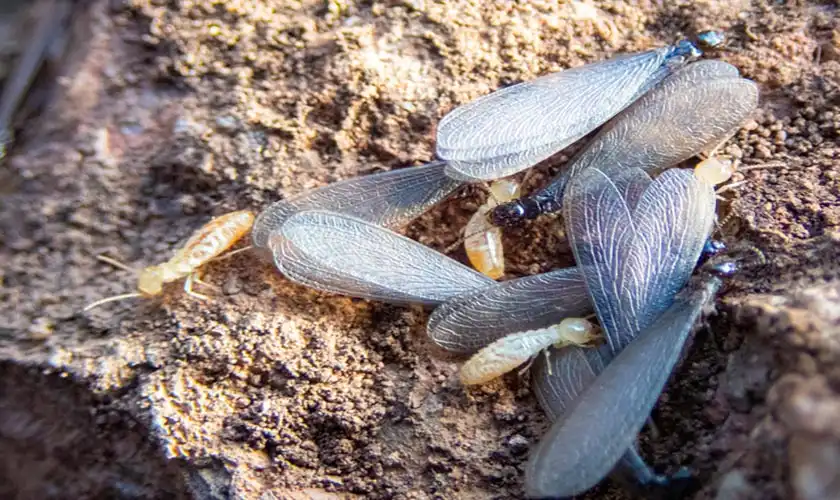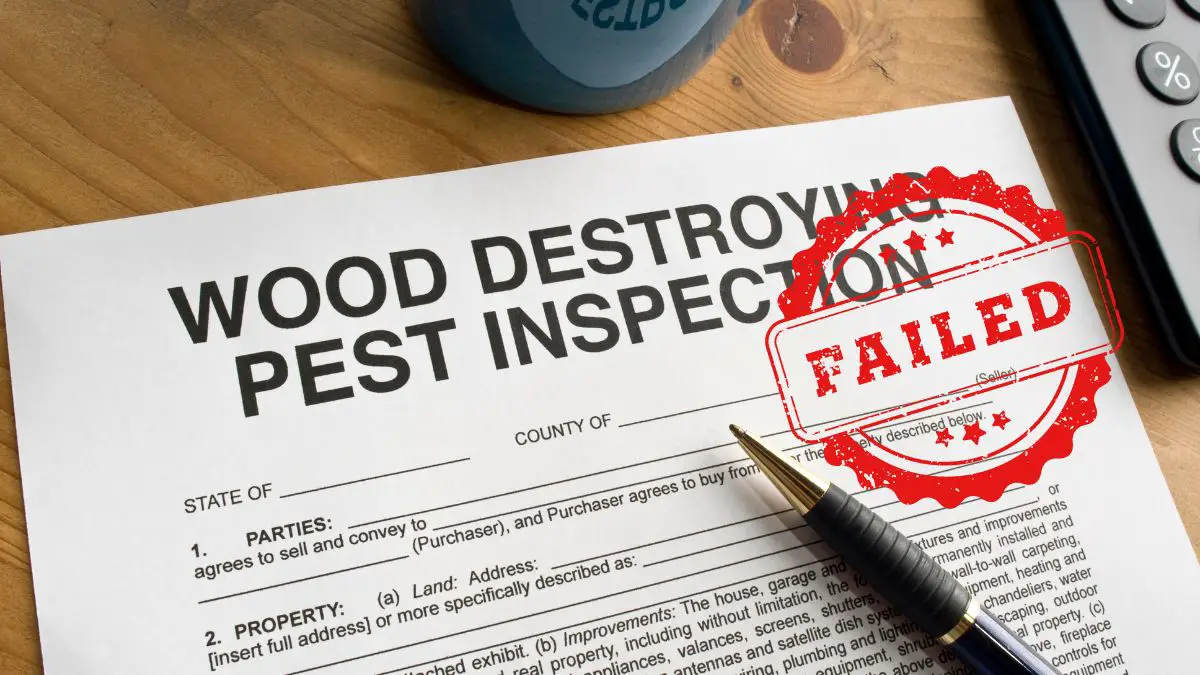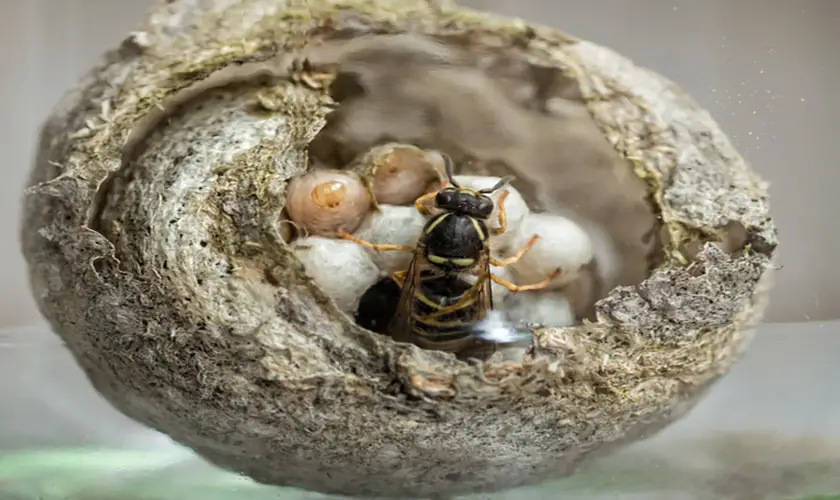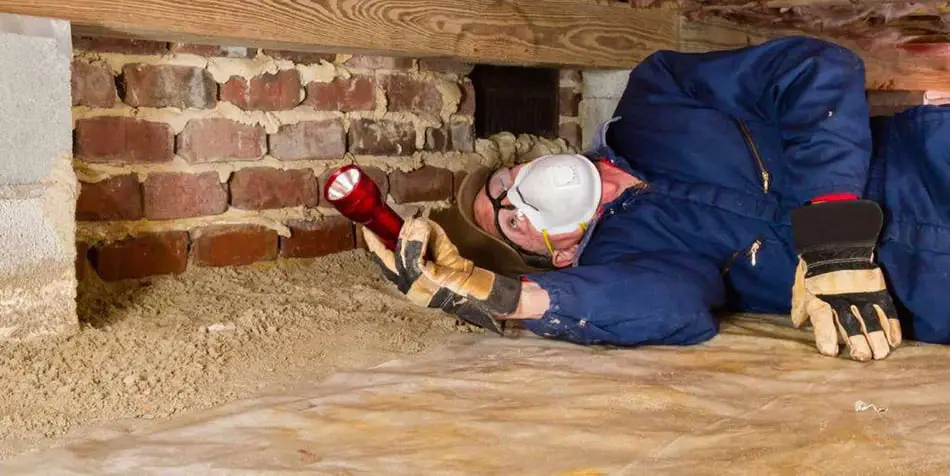If you own a home, you’ve probably pondered what do termites eat. Termites are known for their destructive nature, causing millions of dollars to damage homes and buildings yearly. One key factor contributing to their destructive behavior is their eating habits.
Termites are known to consume a variety of materials, with cellulose and lignin being their primary sources of nutrition. Understanding what termites eat is crucial for preventing and treating infestations and protecting your home or business from costly damage.
Termites are small, social insects that can live in colonies numbering from hundreds to millions of individuals. They play a crucial role in the ecosystem as decomposers, breaking down dead trees and plant material into organic matter that can be used to nourish the soil.
However, termites can also cause significant damage to structures, including homes and businesses, by feeding on wood and other materials. Understanding the diet of termites is essential to prevent infestations and minimize property damage.
Every year in the United States, termites damage around 600,000 homes, resulting in an estimated expense of $5 billion for residents who have to control the termites and fix the damages.
According to the United States Department of Agriculture (USDA), U.S. residents spend at least $1 billion annually on controlling and repairing damage caused by Formosan termites. However, some experts suggest that the actual amount could be closer to $2 billion.
What Do Termites Eat: Key Takeaways
- Subterranean termites are the most common type in the United States and need moisture to survive, while drywood termites do not require soil or moisture to survive and live in the wood they eat. Dampwood termites colonize inside and feed on wet or moist wood, such as logs, stumps, and fallen trees.
- Termites’ primary diet is cellulose, found in plant cell walls. They can break it down into simpler compounds that they can use for energy and other essential functions with the help of microorganisms in their digestive systems.
- Termites may also feed on non-cellulose-based materials like fungus, algae, and synthetic materials. Some subterranean termites have a hybrid diet of wood and fungal material found in the soil.
- Gut microbes play a critical role in the termite’s ability to digest cellulose. They produce enzymes that break down cellulose into simpler components that termites can absorb and use for energy.
- Identifying potential food sources and removing them can make a significant difference in preventing termite infestations.
- Termite inspections and preventative treatments are crucial for new construction homes because they employ more soft wood members line pine.

The Different Types of Termites
Termite species are divided into three main types based on their habitat – subterranean, drywood, and dampwood termites.
Subterranean termites
Subterranean termites are the most common type of termite in the United States and live in large underground colonies. These termites need moisture to survive and build mud tubes to reach their food sources. Their diet primarily consists of cellulose-based materials like wood and plant matter.
Drywood termites
Drywood termites live in the wood they eat and do not require soil or moisture to survive. They typically infest and feed on dry wood, including structural timbers, furniture, and flooring. Unlike subterranean termites, drywood termite infestations don’t build tunnels, so their presence in wood can be hard to detect until the damage is done.
Dampwood termites
Dampwood termites live in and feed on wet or damp wood, such as logs, stumps, and fallen trees. They are typically found in areas with high moisture. They are less common in residential properties because they require significant moisture to survive, which can be difficult to find indoors.
Understanding the different types of termites and their habitats is crucial for developing effective termite management strategies. Each type of termite has specific dietary requirements, and prevention methods may vary based on the type of termite. The following sections will delve into the different termite diets in more detail.
Understanding Termite Diets
Termites are known for breaking down tough plant fibers, primarily cellulose, into simpler compounds that they can use for energy and other essential functions. Termites may also feed on non-cellulose-based materials like fungus, carpets, clothing, and plastics.
Here are the three main types of termite diets:
Cellulose-based diet
The termite’s primary diet is cellulose, the compound found in plant cell walls that gives plants their structural strength. Cellulose is a complex carbohydrate that termites can break down with the help of microorganisms that live in their digestive systems.
Termites feed on any materials containing cellulose:
- Wooden structural members and building materials like trim broads and exterior siding
- Dead wood like tree roots, tree stumps, bark, and wood chip mulch
- Paper products like cardboard, books, newspaper, etc.
- Fabrics like carpet, wool, cotton fibers, etc.
Non-cellulose-based diet
Termites may also feed on non-cellulose-based materials, including:
- Fungi: Termites will feed on fungus that grows in moist, dark places, such as under sinks and basements.
- Algae and lichen: Certain termites consume algae and lichen that grow on trees and rocks.
- Plastic and other synthetic materials: Termites have been known to chew through plastics, rubber, and other synthetic materials to get to a cellulose food source.
Hybrid diet
Some termites consume both cellulose and non-cellulose materials. For example, some subterranean termites have a hybrid diet of wood and fungal material in the soil.
Understanding the termite’s diet is essential to help prevent infestations and minimize damage to homes and businesses. Identifying potential food sources and removing them can make a significant difference in preventing termite infestations.
Cellulose-Based Diet
Cellulose is the main component of termites’ diet, and their ability to break it down into simpler compounds is essential for survival. Termites have a unique ability to digest cellulose with the help of microscopic organisms, such as bacteria, protozoa, and flagellates, that live in their digestive systems.
Breakdown of cellulose
Termites digest cellulose through anaerobic fermentation, where microorganisms break down the complex carbohydrate into simple compounds like glucose, which termites can then use for energy. The termite’s digestive system’s microorganisms produce enzymes that break cellulose into digestible sugars.
Sources of cellulose in the environment
Cellulose is abundant in the environment, and termites can feed on various cellulose-based materials, including wood, paper, plywood, cardboard, and other plant material. Termites ingest these materials, and the microorganisms in their digestive systems break down the cellulose.
The role of gut microbes
Gut microbes play a critical role in the termite’s ability to digest cellulose. The microorganisms in the digestive system of termites produce enzymes that break down cellulose into simpler components that termites can absorb and use for energy.
Termites do not produce these enzymes but are instead produced by the microorganisms living in their gut. Research has shown that subterranean termites, for example, have over 400 different species of bacteria in their gut that enable them to digest cellulose.
Non-Cellulose-Based Diet
While cellulose is the primary component of termites’ diet, it can also feed on non-cellulose-based materials such as fungus, algae, and synthetic materials.
Other food sources for termites
- Fungi: Some termites, especially dampwood termites, can feed on fungi. The fungi provide the termites with nutrients and moisture, allowing them to survive without dependence on cellulose alone. Termites may feed on fungi growing on damp wood, carpeting, and drywall.
- Algae and Lichen: Certain termites feed on algae and lichen that grow on trees, rocks, and soil. The termites break down the algae and lichen with their enzymes to release the necessary nutrients.
- Synthetic Materials: Termites can chew through synthetic materials such as plastics, rubber, and other materials not part of their natural diet. They do this to find a cellulose-based food source. Synthetic materials can weaken a structure’s foundation and provide an entry point for termites to access the cellulose-based materials they consume.
Fungus-Based Diet
Termites with a fungus-based diet have evolved to rely on fungi and cellulose-based materials. These termites often have a mutualistic relationship with the fungi, benefiting both species. The termites provide the fungi with a stable environment, food, and transportation, while the fungi provide the termites with nutrients and moisture.
Algae and Lichen-Based Diet
Some termites rely on algae and lichen as their primary food source. The cellulose in the plant material provides termites with energy and the nutrients they need to survive. These termites have adaptations that allow them to break down and digest the cellulose, making them better suited to feed on these materials.
Hybrid Diet
Some termites consume both cellulose and non-cellulose-based materials and have what is known as a hybrid diet. These termites typically have a combination of cellulose and non-cellulose-based foods in their diet.
Combination of cellulose and non-cellulose-based diets
Termites with a hybrid diet have adapted to consume cellulose and non-cellulose-based materials. They have evolved to break down materials such as wood, paper, and other plant matter, as well as algae, lichen, and even synthetic materials.
Examples of termites with hybrid diets
- Subterranean Termites: Some subterranean termites have a hybrid diet of wood and fungal material in the soil. These termites consume the wood for cellulose, and the fungi break down the cellulose for nutrients.
- Drywood Termites: Drywood termites usually have a cellulose-based diet. However, they can consume other materials such as paint, wallpaper, and fabrics that have cellulose as their main component.
Understanding the hybrid diets of termites can help homeowners and pest control specialists design an effective termite management strategy. Identifying the potential food sources makes it possible to create a less attractive environment for termites and reduces the likelihood of infestation.
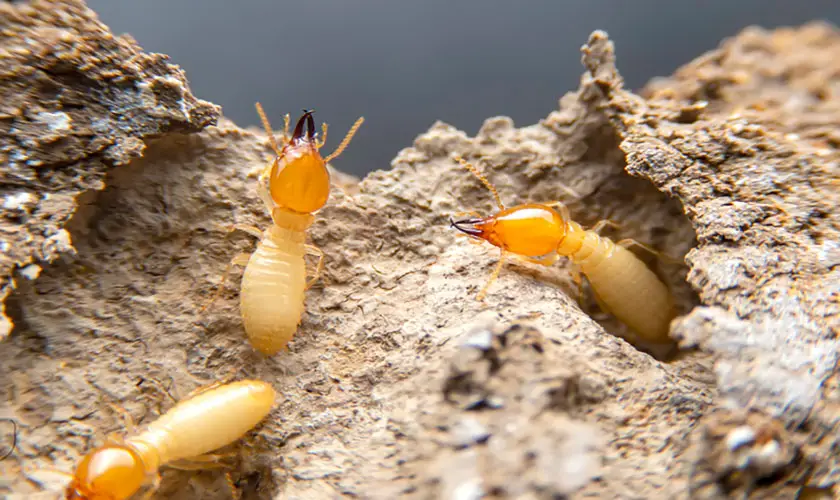
Why Do Termites Eat Wood?
Termites eat wood because it is an abundant cellulose source, a carbohydrate found in plant cell walls. Cellulose is the main component of wood, making it an ideal food source for termites.
Termites can digest cellulose through their protozoan symbionts, which break down the complex molecules into simpler forms that the termite can use.
The resulting breakdown products provide nutrition for both the symbiont and the termite. In addition to cellulose, termites feed on other materials such as paper, insulation, and other wood products.
What Types of Wood Do Termites Eat?
Termites feed on many different types of wood, but they prefer some over others. Here are some examples of the types of wood that termites are most likely to consume:
- Softwoods: Softwoods are often preferred by termites because they have a lower density and are easier for insects to chew through. This includes woods like pine, fir, and spruce.
- Hardwoods: While termites are less likely to feed on hardwoods, they can still damage them. Hardwoods like oak, ash, and maple are denser and more difficult for termites to chew through. They may still be susceptible to infestation if they are in an environment with a high termite population.
- Decaying wood: Termites prefer already decaying wood because it is easier to break down. This includes wood that is wet, water-damaged, or has been exposed to the elements for a long period of time.
- Treated wood: Wood treated with chemicals to prevent termite infestations can also be consumed by termites, although it may take longer. Treated wood should still be protected and monitored for signs of termite activity.
It is essential to be aware of the types of wood that termites are attracted to if you want to prevent infestations and protect your property. Regular inspections by a pest control professional can help identify signs of termite activity and prevent damage to the wooden structure of your home or business.
Factors that Influence Termite Eating Habits
Termites are highly adapted insects that can digest cellulose, the main component of wood, with the help of specialized gut bacteria. However, their feeding habits are not solely determined by the availability of wood. Several factors can influence termite feeding behavior:
Temperature
Termites are sensitive to temperature changes and have specific temperature preferences for optimal growth and development. Some species of termites prefer warmer temperatures, while others prefer cooler temperatures. Temperature can also affect the rate at which termites feed, with higher temperatures generally resulting in faster feeding.
Humidity
Humidity is another important factor that can affect termite feeding behavior. Termites require a certain level of moisture to survive and thrive. Dry conditions can slow their feeding and growth, while overly wet conditions can lead to fungi that can be harmful to termites. Maintaining proper humidity levels in your home or business can help deter termites from infesting.
Availability of food
Food availability is the most important factor determining termite feeding behavior. Termites will seek out wood and other materials containing cellulose if they are present. They may turn to other materials, such as paper, cardboard, or clothing made from plant-based fibers if wood is unavailable.
Understanding these factors that influence termite feeding behavior can help you take preventative measures to protect your property from termite damage.
Controlling temperature and humidity levels and minimizing potential food sources can reduce the likelihood of a termite infestation. Regular inspections by a pest control professional can also help detect and prevent infestations before they cause extensive damage.
Signs of Termite Infestation
Active termites are often called “silent destroyers” because they can cause significant damage to a property before their presence is even detected. Here are some common signs of termite infestation to watch out for:
Damaged wood
Termites feed on wood from the inside out, leaving only a thin layer of paint or surface material intact. This can make it difficult to detect termite damage until it is severe. Look for buckling or swollen floors, loose tiles, or sagging ceilings, as these can be signs of termite damage.
Mud tubes
Subterranean termites build mud tubes (aka shelter tubes) to protect themselves while traveling between their colony and food source. These tubes are typically made of mud and are about the width of a pencil. Look for mud tubes on walls, foundation walls, or crawl spaces.
Discarded wings
Termites swarm in search of new locations to start a termite colony. After finding a suitable location, they shed their wings, leaving them behind in piles. Look for piles of wings near doors, windows, or other entry points.
Prevention and Treatment of Termite Infestations
Preventing a termite infestation is much easier and less expensive than treating an existing infestation. Here are some preventative measures you can take:
Reduce moisture
Active termites require moisture to survive, so it’s important to reduce any sources of moisture in and around your property. Fix leaky pipes, ensure proper drainage around the foundation, and use dehumidifiers in damp areas.
Store wood properly
If you have firewood or other wooden materials, store them off the ground and away from the foundation of your home or business.
Remove food sources
Termites feed on wood and other materials containing cellulose. Remove any dead trees or stumps, and avoid storing cardboard boxes, paper, or other cellulose-containing materials in areas prone to termite infestations.
Regular inspections
Regular inspections by a pest control professional can help detect termite infestations before they cause significant damage. A professional can identify signs of termite activity and recommend preventative measures to reduce the likelihood of an infestation.
If you suspect a termite infestation, it’s important to contact a pest control professional as soon as possible. Treatment options may include liquid termiticides, bait systems, or a combination of both. The treatment method will depend on the severity of the infestation and the type of termites present. A professional can recommend the best treatment option for your specific situation.
Get FREE quotes from licensed pest control technicians in your area today. Whether you need a termite inspection or a full treatment, We Can Help! All technicians are screened, licensed, and insured.
What Do Termites Eat FAQs
What is a termite’s favorite food?
Termites are detritivores that feed mainly on cellulose found in wood, grass, leaves, humus, manure of herbivorous animals, and materials of vegetative origin. They prefer to snack on the cellulose fibers found in wood, but they can also eat other plant matter such as fruits, vegetables, and other organic materials. Cellulose is the most abundant organic compound and essential for termites to survive.
Do termites eat wood or chew it?
Termites eat wood, not just chew it. They feed on cellulose found in wood and other plant matter, which allows them to digest and process their food source.
Do termites eat plastic?
No, termites do not feed on plastic, but they may use their jaws to break through it if they need to get to a food source. They are more likely to chew through materials like wood, paper, and cardboard that contain cellulose.
Do termites eat clothes?
Yes, termites will eat any material that contains a plant material called cellulose, such as wood, clothing, books, and more. Termites are attracted to natural clothing fibers like cotton because it contains cellulose.
Do termites eat dog food?
Termites prefer to feed on items with a cellulose compound, such as wood, insulation, books, and paper, but they could also feed on pet food and animal feces if no other food source were present. Other pests like ants and beetles may be attracted to pet food, but termites will not primarily feed on dog food.
Conclusion
Understanding what termites eat is critical for preventing infestations and minimizing damage to property and structures. Termites primarily consume cellulose-based materials, such as wood and plant matter. However, they can also feed on non-cellulose-based materials, including algae, lichen, and synthetic materials. Some termites have a hybrid diet, consuming both cellulose and non-cellulose-based materials.
Identifying potential food sources for termites and removing them is essential to prevent infestations. This can include keeping firewood and other wooden materials away from your home’s foundation, ensuring proper ventilation to minimize moisture levels, and eliminating piles of debris and other materials that may attract termites.
It is also essential to have regular termite inspections conducted by a professional pest control company to identify early signs of infestations and prevent serious damage to your home or business.
By better understanding the termite’s diet and its sources, homeowners and pest control specialists can take the necessary steps to prevent infestations and minimize damage. Be sure to take all preventative measures to protect your property from the destructive nature of termites.
Sources


